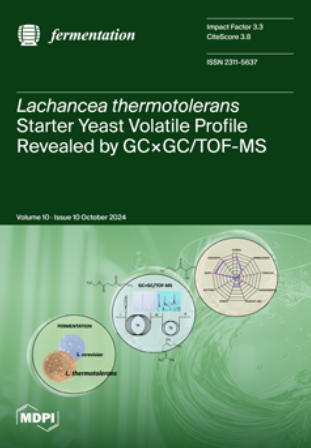新型深海真菌分泌体木质纤维素水解活性的诱导与表征
IF 3.3
3区 农林科学
Q2 BIOTECHNOLOGY & APPLIED MICROBIOLOGY
引用次数: 0
摘要
人们越来越认识到真菌能够在极端环境中生存。深海被认为是一个极端的环境,因为它的低温,高静水和静岩压力,3.5%的盐度,低氧,营养和光的可用性。生活在深海中的真菌可能已经进化到能够产生蛋白质,使它们能够在这些条件下生存。来自深海等极端环境的真菌木质纤维素水解酶的研究和特性是必要的,因为它们可能具有不同寻常的适应性,在工业上是有用的。因此,这项工作旨在详细描述从大西洋深海沉积物中分离的真菌的木质纤维素分解能力,以及比较木质纤维素分解的陆地分离物。分离株为海洋绿绿杆菌、青霉菌、南极青霉和斯托利Talaromyces stollii。以麦麸为主要碳源,通过液相发酵(LSF)诱导木质纤维素水解酶,并通过生化分析和凝胶蛋白组学对酶的特性进行了评价。该研究表明,该菌株耐盐,在较宽的pH和温度范围内产生木聚糖酶,并产生多种糖苷水解酶和阿魏酰酯酶活性。stollii分泌组表现出显著的外糖苷水解酶活性,在pH 1.5-6.0和温度1-60°C之间木聚糖酶活性最佳,使该分离物成为生物技术应用的理想候选者。本研究首次定量测定了E. maritima、P. antarcticum和一个海洋T. stollii菌株分泌的木聚糖酶活性和外糖苷水解酶活性。这项研究也是第一个定量表征海洋菌株在LSF期间的木聚糖酶活性。本文章由计算机程序翻译,如有差异,请以英文原文为准。
Induction and Characterisation of Lignocellulolytic Activities from Novel Deep-Sea Fungal Secretomes
Fungi are increasingly recognised as being able to inhabit extreme environments. The deep sea is considered an extreme environment because of its low temperatures, high hydrostatic and lithostatic pressures, 3.5% salinity, and low oxygen, nutrient and light availability. Fungi inhabiting the deep sea may have evolved to produce proteins that allow them to survive these conditions. Investigation and characterisation of fungal lignocellulolytic enzymes from extreme environments like the deep sea is needed, as they may have unusual adaptations that would be useful in industry. This work, therefore, aimed to profile in detail the lignocellulolytic capabilities of fungi isolated from deep-sea sediments in the Atlantic Ocean, and a comparative lignocellulolytic terrestrial isolate. The isolates were strains of Emericellopsis maritima, Penicillium chrysogenum, P. antarcticum and Talaromyces stollii. Lignocellulolytic enzyme induction was achieved using liquid-state fermentation (LSF) with wheat bran as the main carbon source, while enzyme characteristics were evaluated using biochemical assays and gel-based proteomics. This study revealed that the isolates were halotolerant, produced xylanase over wide pH and temperature ranges, and produced a variety of glycoside hydrolase and feruloyl esterase activities. The T. stollii secretome demonstrated remarkable levels of exo-glycoside hydrolase activity, with xylanase activity optimum between pH 1.5–6.0 and temperatures between 1–60 °C, making this isolate an ideal candidate for biotechnological applications. This study is the first to quantitatively characterise xylanase activities and exo-glycoside hydrolase activities secreted by E. maritima, P. antarcticum and a marine T. stollii strain. This study is also the first to quantitatively characterise xylanase activities by a marine strain of P. chrysogenum during LSF.
求助全文
通过发布文献求助,成功后即可免费获取论文全文。
去求助
来源期刊

Fermentation-Basel
BIOTECHNOLOGY & APPLIED MICROBIOLOGY-
CiteScore
3.80
自引率
18.90%
发文量
594
审稿时长
7 weeks
期刊介绍:
Fermentation-Basel is an international open access journal published by MDPI, focusing on fermentation-related research, including new and emerging products, processes and technologies, such as biopharmaceuticals and biotech drugs. The journal enjoys a good reputation in the academic community and provides a high-impact forum for researchers in the field of bioengineering and applied microbiology.
 求助内容:
求助内容: 应助结果提醒方式:
应助结果提醒方式:


